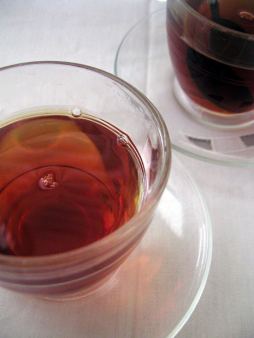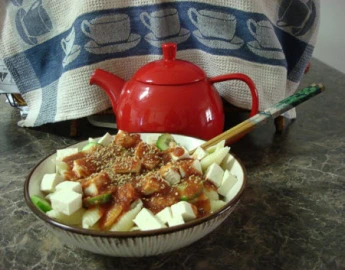A good percentage of my friends on Facebook are people involved with tea, whether professionally or as an interest. Recently I got a request from someone who had identified as “Tea Master So-and-so.” I was expecting to see an old wrinkled face as their profile photo, and was surprised when the person looked like they were in their 30s. This was a”Tea Master?” Really?
I didn’t accept the friend request, altho’ I’m sorry now that I didn’t because I would have liked to have asked this person what exactly made them a Tea Master. Clearly it wasn’t a long lifetime spent learning, working with, and perhaps teaching, all aspects of tea. So where did the designation come from and what did it really mean?
Some years ago, someone who was a member of my now pretty-much defunct online tea-business discussion group contacted me about a business he was part of, teaching classes and seminars about tea and the business of tea. He told me that they conferred the title of Tea Master on their student/clients who successfully completed the course of study. He also referred to himself as a Tea Master. I asked him who had given him that title — what individual or organization? His response was that he had “taken all the courses” and had the experience necessary to be a Tea Master, and refused to answer my questions about the origins of the title because he felt that I was “too judgmental.” I finally drew my own conclusion that the person had simply chosen to apply the designation to himself. (I still have the email exchange filed away lest anyone doubt the accuracy of my memory. And I would still welcome a response to my question.)
A couple of years later, I was reading about a person in their twenties who had become America’s youngest Tea Master and had opened a tea salon. I suspected that there was some relationship between the two “Tea Masters”, and it turns out that the younger had been the student/client of the older (or more experienced?). One of the comments in the article — actually a public-relations matte written by a publicist — was: “[This person] can even discern the difference between a first-flush Darjeeling and a regular [sic] Darjeeling.” Now, while I’m aware that there are several flushes of Darjeeling pluckings between early spring and mid-Autumn, I’m not aware of any of the teas from any of these flushes being referred to as “regular” Darjeelings. I had never heard the term before and have not heard it since.
In fact: It has been my experience that pretty much anyone who tastes a first-flush Darjeeling can perceive the difference between that tea and teas from later flushes. This was one of the first things I learned about fine tea, graciously explained and demonstrated to me at the Harney tasting room by John Harney himself. I also mentioned this comment to my dear husband, who enjoys tea but will be the first to tell you that he knows very little about it; he observed that even in his limited experience he can spot a first-flush Darjeeling essentially from the first sip. Not only do neither of us claim the title of Tea Master for this un-extraordinary accomplishment, we’d be shocked if anyone suggested that this had earned us the title!

Image courtesy of TheSpiritScience.net
My purpose for writing this is not to denigrate anyone’s knowledge of and skill with tea, nor to suggest that anyone should not parlay the love and knowledge of tea into a profitable business. It’s just that “Tea Master” seems a rather grandiose and presumptuous title to adopt, or confer, as a result of taking courses, passing tests, and perhaps visiting some tea-growing, tea-processing, and tea-service facilities on a more or less tourist basis. There are people who have worked on tea plantations all their lives, and who have mastered many aspects of tea production and usage, who do not identify as Tea Masters. It is not a title to be bandied about lightly, nor conferred on anyone who has not spent a long lifetime involved with tea.
Again some years ago we had a discussion about this very topic amongst the members of my (still active) online tea discussion group
Teamail. One of the points made was that the title “Master” should be conferred by consensus of others in the tea world who are familiar with a person’s skills, knowledge, and achievements. Or, as another member — a member who is, by the way, extremely knowledgeable and experienced in all things tea — suggested, perhaps the title of Tea Master is one that should be awarded posthumously.
None of the tea people I’ve come to know, either in person or through their writings, that I would consider a Tea Master has been willing to accept this designation. Some of the more accomplished amongst them, people who have spent a lifetime immersed in all things tea, have even been quite vehement in their refusal.
Back when I was studying psychology in college, one of our profs explained to us the requirements for being an expert witness in a court of law. To be accepted as an expert witness, a person must convince a judge and opposing counsel that s/he has more knowledge of a topic than the average person; this is done by demonstrating that they teach, consult, write about, or otherwise make their living or are recognized in the community as having this kind of experience and expertise. According to that definition, I am quite willing — as I suspect most of us are — to grant that anyone who has spent a significant portion of their time learning, teaching, consulting, writing about, or otherwise making their living in any area related to tea is indeed a tea expert. But “Tea Master?” No indeed. I admit that I subscribe to the “posthumous” designation for this title, and am unable to respect anyone who identifies themself with the title.
Follow TeaGuide on Twitter @TeaGuide1
Friend TeaGuide on Facebook
Contact us by email about reviewing your tea or tea-related product, or to be interviewed.
We love to hear your comments!
All content Copyright 2007-2015 JP Badarau; all rights reserved.

 What’s the cure for the common cold? Although there is none, most medical professionals recommend treating a cold with plenty of bed rest to preserve your strength, along with eating lots of hot soup and drinking lots of hot liquids to loosen congestion. One of the most healthful liquids to drink, especially when you have a cold, is hot tea.
What’s the cure for the common cold? Although there is none, most medical professionals recommend treating a cold with plenty of bed rest to preserve your strength, along with eating lots of hot soup and drinking lots of hot liquids to loosen congestion. One of the most healthful liquids to drink, especially when you have a cold, is hot tea.

 My first test was with a slightly smoky Georgia tea, because I like a cup of smoky tea with spicy foods. Yummy! When I fixed the dish with rice noodles I tried genmaicha, a user-friendly green tea mixed with toasted rice kernels. Another hit! Then came the day when I really wanted this dish but didn’t feel like steeping up another pot of tea, so in my laziness I used leftover oolong tea. Bingo once again!
My first test was with a slightly smoky Georgia tea, because I like a cup of smoky tea with spicy foods. Yummy! When I fixed the dish with rice noodles I tried genmaicha, a user-friendly green tea mixed with toasted rice kernels. Another hit! Then came the day when I really wanted this dish but didn’t feel like steeping up another pot of tea, so in my laziness I used leftover oolong tea. Bingo once again!